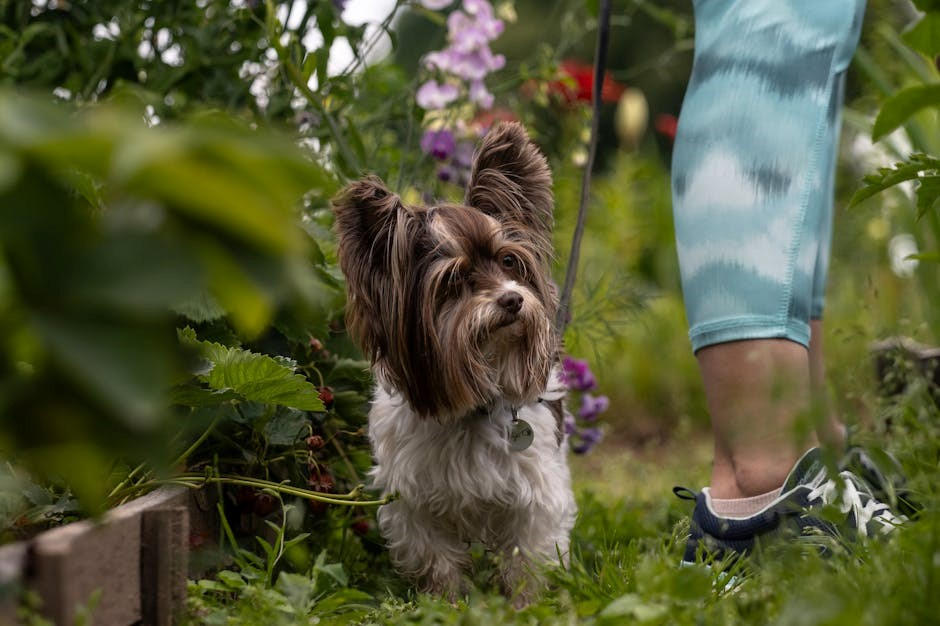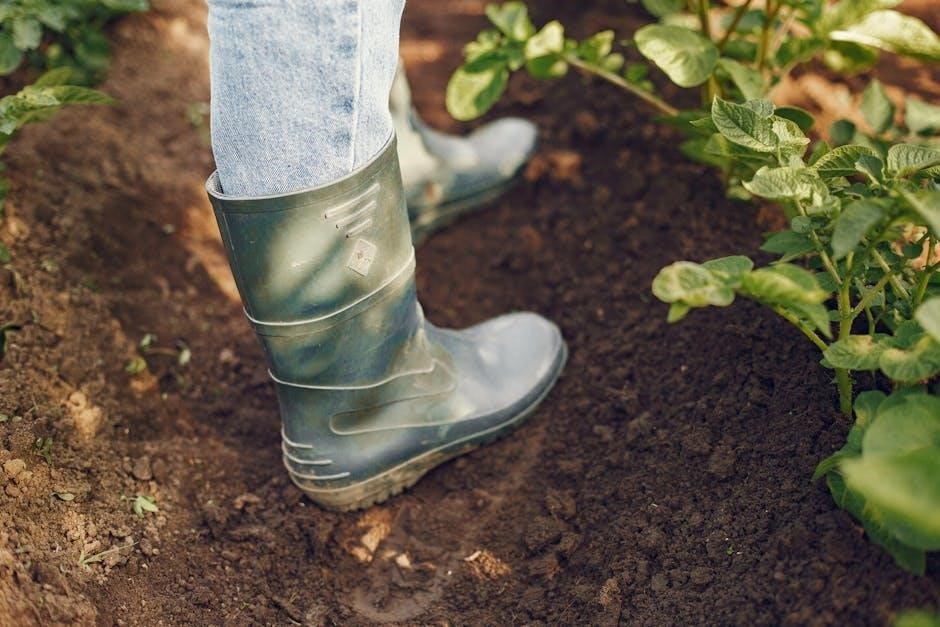
Square foot gardening is a space-efficient method that organizes gardens into small, manageable sections, often using companion planting charts to optimize growth and reduce waste.

1.1 What is Square Foot Gardening?
Square foot gardening is a highly efficient gardening method that maximizes space by dividing the growing area into small, manageable squares, typically 1×1 foot. Developed by Mel Bartholomew, this technique focuses on optimizing space, reducing waste, and increasing yields. It involves creating a grid of raised beds filled with a specific soil mix, ensuring proper drainage and nutrient distribution. Each square is planted with a specific number of plants, depending on their mature size, to avoid overcrowding. This system is ideal for small spaces, such as urban gardens or backyard plots, and promotes organized, productive gardening. By using companion planting charts, gardeners can further enhance growth and deter pests, making square foot gardening a sustainable and rewarding approach for growers of all skill levels.
1.2 History and Development
Square foot gardening was first introduced in the 1980s by Mel Bartholomew, an American gardening expert, as a revolutionary approach to maximize garden space. Bartholomew’s method emphasized dividing gardens into 1×1 foot squares, each containing a specific number of plants based on their size. This system eliminated the need for rows, reducing space and water waste. The technique gained popularity through Bartholomew’s book, “Square Foot Gardening,” which detailed the grid-based layout and soil optimization. Over the years, gardeners have adapted the method to incorporate companion planting, creating charts to guide plant placement and enhance growth. Today, square foot gardening remains a popular choice for urban and small-space gardeners, offering a practical and efficient way to grow vegetables, herbs, and flowers while minimizing resources.
Benefits of Square Foot Gardening
Square foot gardening maximizes space efficiency, reduces water consumption, and optimizes nutrient use. It’s ideal for small gardens, promoting high yields while minimizing waste and effort.

2.1 Space Efficiency
Square foot gardening excels in space efficiency by dividing plots into one-square-foot sections. This method allows gardeners to maximize yields in small areas, ensuring every inch is utilized effectively.
It minimizes wasted space by arranging plants in a grid, making it perfect for urban settings or backyard gardens.
The structured layout also simplifies maintenance and planning, ensuring optimal plant placement for growth and health.
This approach is particularly beneficial for beginners, as it provides clear guidelines for plant spacing and arrangement.
By focusing on compact, organized growing areas, square foot gardening turns even the tiniest spaces into productive gardens.
2.2 Resource Optimization
Square foot gardening is highly resource-efficient, minimizing water, nutrients, and labor. Its grid-based design ensures precise water distribution, reducing waste and focusing resources where needed.
The method promotes companion planting, which enhances growth and flavor while deterring pests naturally, reducing reliance on chemicals.
By optimizing space, it allows gardeners to grow more with fewer inputs, making it ideal for small or urban areas.
This approach also reduces soil erosion and improves fertility through structured planting and maintenance.
Overall, square foot gardening offers a sustainable way to maximize yields while conserving resources, making it a popular choice for eco-conscious growers.

Understanding Companion Planting
Companion planting enhances growth by pairing plants that benefit each other, deterring pests, and improving flavors, while optimizing space in square foot gardens.
3.1 Definition and Purpose
Companion planting is a gardening technique where plants are strategically paired to enhance growth, deter pests, and improve soil health. Its purpose is to create a balanced ecosystem, maximizing space efficiency, especially in square foot gardens. By understanding which plants thrive together, gardeners can optimize yields and reduce the need for pesticides. This method also promotes biodiversity, attracting pollinators and beneficial insects, which further supports plant health. The use of a companion planting chart provides a visual guide, simplifying the process of selecting compatible plants for each square foot. This approach not only boosts productivity but also minimizes potential conflicts between plants, ensuring a harmonious and thriving garden environment.
3.2 Benefits of Companion Planting
Companion planting offers numerous benefits, including improved plant growth, natural pest control, and enhanced soil health. By strategically placing plants together, gardeners can deter pests that might harm their crops, reducing the need for pesticides. For example, marigolds repel nematodes, while basil improves tomato flavor and repels insects. Additionally, some plants, like legumes, fix nitrogen in the soil, benefiting neighboring plants. Companion planting also promotes biodiversity, attracting pollinators and beneficial insects. In square foot gardens, this technique maximizes space efficiency by allowing plants to support each other within the same or adjacent squares. A companion planting chart simplifies this process, ensuring gardeners can plan effectively and reap the rewards of a thriving, balanced garden ecosystem. This method is both eco-friendly and productive, making it a cornerstone of successful square foot gardening.
How to Create a Square Foot Garden Layout
Plan your garden using a grid layout, spacing plants according to their size and sunlight needs. Use a companion planting chart to ensure optimal plant placement for growth and efficiency.
4.1 Planning the Layout
Planning the layout for a square foot garden begins with dividing your space into a grid of 1×1 foot squares. Each square can hold one or more plants, depending on their size. Use a companion planting chart to guide your plant placement, ensuring compatibility and maximizing space. Start by sketching your garden bed on paper, marking each square and assigning plants based on their growth habits and sunlight requirements. Consider vertical gardening options for taller plants like tomatoes or peas. This structured approach helps in making the most of your available space while promoting healthy plant growth and reducing competition for resources.
4.2 Choosing the Right Plants
Choosing the right plants for your square foot garden involves selecting varieties that thrive in small spaces and complement each other. Use a companion planting chart to identify which plants benefit from being grown together, such as tomatoes with basil or carrots with sage. Consider the mature size of each plant to avoid overcrowding and ensure proper air circulation. Leafy greens, herbs, and compact vegetable varieties are ideal for square foot gardening. Make sure to select plants with similar sunlight and watering needs to create a harmonious growing environment. By thoughtfully choosing your plants, you can maximize productivity and reduce potential pests or diseases. This approach ensures a balanced and thriving garden layout;

Companion Planting Chart for Square Foot Gardens
A companion planting chart for square foot gardens lists compatible vegetables, herbs, and flowers, ensuring optimal plant compatibility, pest control, and space optimization by enhancing growth and reducing pests.
5.1 Vegetables and Their Companions
Vegetables thrive in square foot gardens when paired with compatible companions. Tomatoes benefit from basil, which repels pests, while carrots and lettuce grow well together, improving flavor and texture. Cucumbers pair with dill to deter aphids, and marigold repels nematodes, protecting tomatoes. Lavender attracts pollinators, aiding vegetables like beans and peas. Onions and garlic repel pests that target cabbage and carrots. Corn, beans, and squash form the “Three Sisters,” enhancing growth and soil health. These combinations maximize space, improve yields, and naturally deter pests, making companion planting a cornerstone of efficient square foot gardening. Charts provide visual guides, ensuring gardeners can easily plan and execute harmonious vegetable pairings for optimal results.
5.2 Herbs and Flowers in Companion Planting
Herbs and flowers play a vital role in square foot gardening by enhancing growth and deterring pests. Basil repels aphids and improves tomato flavor, while marigold discourages nematodes and attracts pollinators. Lavender and roses attract beneficial insects, aiding nearby vegetables. Chives and garlic chives repel aphids and mites, protecting carrots and roses. Nasturtiums deter aphids and whiteflies, benefiting cucumbers and squash. Borage and calendula attract pollinators, boosting tomato and strawberry yields. Herbs like mint and lemongrass can be used strategically to repel pests. Companion planting charts offer detailed pairings, ensuring gardeners can integrate herbs and flowers effectively. This method promotes biodiversity, reduces chemical use, and maximizes space efficiency, making it a cornerstone of successful square foot gardens. Proper planning with these plants ensures a balanced and thriving ecosystem in even the smallest spaces.

How to Read a Companion Planting Chart
Companion planting charts use symbols and legends to show compatible and incompatible plants. Green indicates good pairings, red for bad. Symbols like checkmarks or ‘X’ guide planting decisions. Legends explain abbreviations, such as ‘N’ for nitrogen-fixing plants or ‘P’ for pest repellents. Charts may list vegetables, herbs, and flowers, sometimes with spacing guidelines. They help avoid overcrowding and suggest beneficial combinations, enhancing growth and pest control in square foot gardens. Understanding the symbols and legends is key to maximizing space and plant compatibility effectively.
6.1 Understanding Symbols and Codes
Companion planting charts use specific symbols and codes to guide gardeners. Common symbols include checkmarks for compatible plants and ‘X’ for incompatible ones. Colors like green for positive interactions and red for negative ones are also used. Abbreviations such as ‘N’ for nitrogen-fixing plants or ‘P’ for pest-repellent properties are often included. Numbers may indicate spacing requirements or growth cycles. Some charts use arrows to show which plants benefit others when placed nearby. Legends or keys are provided to decode these symbols, ensuring gardeners understand the chart’s instructions. By interpreting these codes, gardeners can maximize space, avoid harmful plant combinations, and create a balanced ecosystem in their square foot garden. Properly reading the chart is essential for successful companion planting and optimal plant health.
PDF Resources and Guides
Downloadable PDF guides offer detailed layouts and charts for square foot gardening, including companion planting strategies and space optimization tips for efficient gardening.
7.1 Where to Find Square Foot Gardening Charts
Comprehensive square foot gardening charts are widely available online as downloadable PDFs. These resources often include detailed layouts, plant spacing guides, and companion planting recommendations. Gardening websites, blogs, and forums provide free or purchasable templates. Additionally, many gardening communities share printable charts tailored for specific climates or plant types. Online marketplaces like Etsy offer customizable PDF planners, while educational platforms provide charts for educational purposes. These resources are invaluable for planning efficient and productive gardens, ensuring optimal use of space and plant compatibility.
7.2 How to Download and Use PDF Guides
To access square foot gardening companion planting charts, visit official gardening websites, blogs, or marketplaces like Etsy. Download the PDF guides by clicking the provided links or purchasing them if required. Once downloaded, open the files using a PDF viewer. Print the charts for physical planning or use digital tools to zoom in and navigate. These guides typically include layouts, plant spacing, and companion recommendations. Use them to map out your garden, ensuring compatibility between plants. Many PDFs are customizable, allowing you to tailor layouts to your specific needs. Save copies for future reference or share them with fellow gardeners. By following these guides, you can optimize your square foot garden’s productivity and organization effectively.
Common Mistakes to Avoid
Avoid overcrowding and ignoring plant compatibility, as these errors can reduce yields and promote pests. Proper spacing and companion planting ensure a healthy, thriving square foot garden.
8.1 Overcrowding the Garden
Overcrowding is a common mistake in square foot gardening, as it reduces airflow and sunlight, leading to stunted growth and increased risk of disease. Plants need adequate space to thrive, and overcrowding disrupts their ability to absorb nutrients and water efficiently.
Using a companion planting chart can help avoid this by ensuring proper spacing and compatibility. For example, large plants like tomatoes should not be placed next to smaller ones like lettuce, as they may shade or overwhelm them.
To prevent overcrowding, plan carefully, choose compact or dwarf varieties, and stagger planting times. Vertical gardening can also maximize space without overcrowding, allowing air and light to circulate freely. Regular monitoring ensures the garden remains balanced and productive.
8.2 Ignoring Plant Compatibility
Ignoring plant compatibility is a critical mistake in square foot gardening, as it can lead to reduced growth, increased pests, and lower yields. Some plants, when grown together, release chemicals that inhibit others or attract pests.
For instance, tomatoes and onions should not be planted together, as onions can stunt tomato growth. Similarly, beans and onions are incompatible, while marigolds and basil can enhance tomato health. A companion planting chart helps identify these relationships, ensuring harmonious growth in tight spaces.
- Plants like marigolds repel nematodes, benefiting tomatoes.
- Beans and corn grow well together, but beans should avoid onions.
- Nasturtiums deter aphids, protecting cabbage and other Brassicas.
Using a companion planting chart prevents these conflicts, optimizing garden health and productivity.

Tips for Optimizing Space
Maximize space with vertical gardening and succession planting, ensuring efficient use of every square foot for optimal growth and productivity in your garden.

9.1 Vertical Gardening in Square Foot Spaces
Vertical gardening is a stellar way to maximize space in square foot gardens. By using trellises, arbors, or wall-mounted planters, you can grow vining plants like tomatoes or peas upwards, freeing up ground space for other crops. This method not only increases yield but also adds aesthetic appeal to your garden. Incorporating companion planting in vertical setups can further enhance growth; for instance, planting nasturtiums near cucumbers to deter pests. Ensure your structure is sturdy and provides adequate support for climbing plants. With careful planning, vertical gardening can significantly boost productivity in small spaces, making it a key strategy for efficient square foot gardening layouts.
9.2 Succession Planting Strategies
Succession planting is a powerful technique for maximizing yields in square foot gardens. By planting crops in sequential intervals, gardeners can ensure continuous growth and harvest throughout the season. This method involves selecting fast-growing plants to follow slower-maturing ones, making efficient use of space and time. For example, lettuce or radishes can be planted after harvesting tomatoes, allowing the soil to remain productive. Companion planting charts can guide these transitions, ensuring that successive crops benefit from each other. Proper planning involves considering mature sizes, growth rates, and compatibility to avoid overcrowding. Succession planting not only extends the harvest period but also optimizes soil health, making it a key strategy for small-space gardening success. This approach aligns perfectly with square foot gardening principles, enhancing productivity and sustainability.
Square foot gardening, combined with companion planting, offers a sustainable and efficient way to grow produce in limited spaces. As urban gardening gains popularity, the demand for optimized layouts and companion planting charts is expected to rise. Future trends may include digital tools and apps that simplify planning, as well as increased focus on organic and eco-friendly practices. With its space-saving design and resource efficiency, square foot gardening is poised to remain a leading method for home growers. By leveraging companion planting charts and succession strategies, gardeners can achieve higher yields and healthier plants. This method not only enhances food security but also promotes environmental stewardship, making it a cornerstone of modern gardening practices.